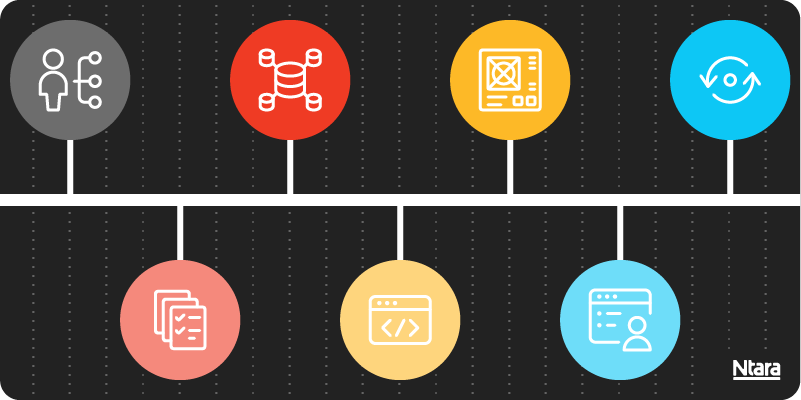Thinking about launching or upgrading your ecommerce platform? Whether you’re replatforming, integrating with a PIM, or finally addressing data chaos, timelines can make or break your success. Let’s break it down with a few factors. Here are 10 ways to keep your ecommerce timeline on track.

Factors that impact ecommerce timelines
To speed up a project, you first need to know what to expect. While every project is unique, key factors often impact timelines. At Ntara, we specialize in mapping these variables early to help clients proactively address them.
Level of customization
At the start of a project, many organizations plan to stick with out-of-the-box ecommerce software. However, as they progress, they realize the platform doesn’t do everything they expected. Maybe the scope shifts, or new design and functional ideas emerge.
So, they choose customization. You want your site to work a certain way? If you can dream it, we can likely build it. Just keep in mind that extensive customization always takes longer than using a standard out-of-the-box functionality, and it can increase cost.
Number and complexity of connections
Whether out-of-the-box or custom, your site needs to pull data from somewhere. The question is, do you know how your data flows or how your systems connect? If not, plan for some analysis upfront. This will help identify where connections—new and existing—are needed.
Complexity is another factor. For example, even a single pricing connection can take days or weeks, depending on its complexity. For example, does your pricing fluctuate often?
Pricing might also be specific to a product, product line, or customer. These types of complex pricing drive the need for frequent updates or real-time pricing, which can add significant complexity and time.
Your plan for product data
Ecommerce requires tons of product data—and not just dry ERP data, but product information that sells. That’s why many businesses start with PIM before they do ecommerce.
At the very least, it’s important to consider the product attributes, images, and information that help drive sales. Where does this data live? Does it need cleanup? How will you send it to your ecommerce site?
A strong ecommerce strategy often starts with PIM. Ntara helps clients evaluate their current data, identify gaps, and choose the right tools—whether that’s PIM or another system. When working with Ntara, this discovery phase typically leads us down one of three paths:
1: No PIM, but want one? That’s where we’ll start.
2: No PIM and don’t need one? Your ecommerce system’s product management may work well for you, right out of the box.
3: Already have a PIM system? There will be some connection work to consider.
No matter the path, clean and enriched product data is a critical step. Our client, Royal Brass and Hose, is a great example. Early in their ecommerce project, they asked for a product data audit. This uncovered data issues that would have tripped up an ecommerce launch, such as incomplete fields, duplicated data, and a lack of imagery and marketing copy.
What’s more, most of their data was managed at the “item” level, i.e., nothing was managed at the “product” level. This was a significant drain on resources, as managing data enrichment across tens of thousands of products at the item level required considerable effort. (Learn more about products and items here.)
Evaluating the options, they chose to invest in a customized instance of Inriver PIM to centralize their data management, enrichment, and distribution. Following that project, with reliable and high-quality data, RBH successfully launched an ecommerce site. Their users love the updated purchasing experience, which sees consistent revenue increases of more than 30% month over month.
10 ways to keep ecommerce timelines on track
Delays aren’t unusual. At Ntara, we’ve seen it all. More importantly, we know what works to keep things moving. Here are 10 ways we’ve found to keep ecommerce timelines on track.

1. Assess your readiness
Readiness often depends on your other upgrade plans. Why? Because ecommerce relies on other systems, such as ERP or PIM, for essential data. If you’re launching new systems, your site experience won’t function properly until those systems are live.
Pro tip: Launching multiple systems at once can cause delays, but planning for system dependencies early in the project helps keep your plans on track.

2. Understand and follow milestones
Don’t put the cart before the horse. Successful ecommerce projects follow a proven order. To stay on track, you need to understand the right sequence of work and check off key milestones before moving from one phase to the next.
Pro tip: Plan accordingly. For example, get your product data in order, incorporate pricing, then move on to design and display. Following the ideal sequence helps prevent rework and delays.

3. Define a product owner
Product or project owner, manager, or lead—whatever you call the role, you need one. This person aligns internal teams, serves as the primary point of understanding, and drives the project forward.
Pro tip: Empower your product owner to make decisions quickly. Delayed decisions are a major cause of project delays, so having a defined, empowered decision-maker helps each project stay on track.

4. Communicate often
Responsiveness across the board keeps things moving! If you’ve established a product/project owner, you’re already ahead of the game. Projects with a proactive internal leader who responds quickly tend to be the most successful.
Pro tip: Quick replies, clear updates, and proactive communication help prevent unnecessary delays.

5. Prioritize your MVP
If everything is priority one, then nothing is. Consider what features are critical at launch. Start with an MVP. Get live sooner. Then, continue that momentum by adding features over time.
This is where your product owner comes in clutch, getting everyone aligned on what’s essential for launch and what can wait. The simpler you start, the sooner you can go live. You can always optimize and add features in future sprints.
Here’s another story from our client Hyster-Yale Materials Handling. We helped roll out their PIM + ecommerce project, bringing a unified experience to their dealers and customers. Since launch, we’ve continued adding features that their users love:
- Shared carts and multi-cart checkouts for easy ordering
- E-procurement punchout connection to simplify purchasing
- Detailed assembly diagrams for quick reference
- Custom engineering and design data to explore modifications
- MyFleet to track equipment and make ordering efficient
Pro tip: Once you’ve nailed down your MVP, put it in writing. That way, when new requests pop up, you can clearly see what fits the launch plan—and what might push your timeline back.

6. Create a clear project plan
Create a clearly defined plan that considers your goals for the site and what’s included in your MVP. Then, control the bright shiny objects. Even small changes can cause big delays.
Pro tip: Empower your project owner and governance team, so they can weigh decisions against your project plan and determine whether a change is worth the delay.

7. Set realistic expectations
Don’t commit to a timeline until you’re confident it’s achievable. If you’ve defined your MVP, you’ll have a clearer idea of what’s reasonable, but there’s more to consider.
Security requirements, architecture review boards, and approval processes can all impact timelines. Without visibility into these or a support person to guide the process, things can slow down fast. And remember, development is just one part of the puzzle. QA, UAT, and other reviews also take time.
Pro tip: Avoid having to backtrack by being realistic up front. Define a timeline and manage expectations accordingly.

8. Stick to consistent standards
One of the biggest causes of delays in ecommerce projects is a lack of clear standards, or failure to adhere. Even minor inconsistencies can trip up a project. Avoid unnecessary complexity. It’s one of the biggest drivers of delays.
Pro tip: Any time you stray from standards, it slows things down. Keep the logic simple and keep it consistent.

9. Establish global governance
Many ecommerce projects retire legacy platforms and bring multiple business units—often multiple geographies around the globe—into one unified system. That means reconciling different ways of doing things, and let’s be honest. It can be pretty challenging to get everyone to agree.
Along with setting standards, figure out how you’ll govern from a global perspective. Your product owner and governance team should lead this process to keep things on track.
Pro tip: Get alignment early. Trying to backtrack and resolve disagreements later can lead to significant delays.

10. Prep documentation
Good site documentation speeds up projects. When you clearly outline use cases and get sign-off, it ensures alignment from the start.
It also makes handoffs smoother. When developers know exactly what to do, work moves faster. And if key team members leave, documentation prevents knowledge gaps. We’ve seen companies with complex, custom systems struggle when new developers step in. But with documentation, they can quickly understand how the site should work, track the history of approvals, and quickly identify a fix to any issues.
Pro tip: The need for documentation depends on complexity. A simple, out-of-the-box B2C setup may not require much. But, if your system has multiple roles, permissions, or geographical differences, documentation is critical. Without it, you’ll waste hours digging through code and trying to piece things together. If you work with Ntara, this is a service we offer. We have helped many clients along their documentation journey.
Jumpstart your ecommerce upgrade
As you can see, these steps work together to help keep your ecommerce timeline on track. Depending on how custom or complex your site is, your timeline may vary. But there are always ways to streamline the process.
Either way, our goal is to get your business exactly what it needs. We know what to expect and have successfully led many ecommerce projects, with or without PIM and DAM, for both B2B and B2C companies.
Regardless of where you’re starting, we can help you define the right strategy, streamline your data and assets, and drive digital growth. Learn more about what you get from an ecommerce project with Ntara. Get in touch.